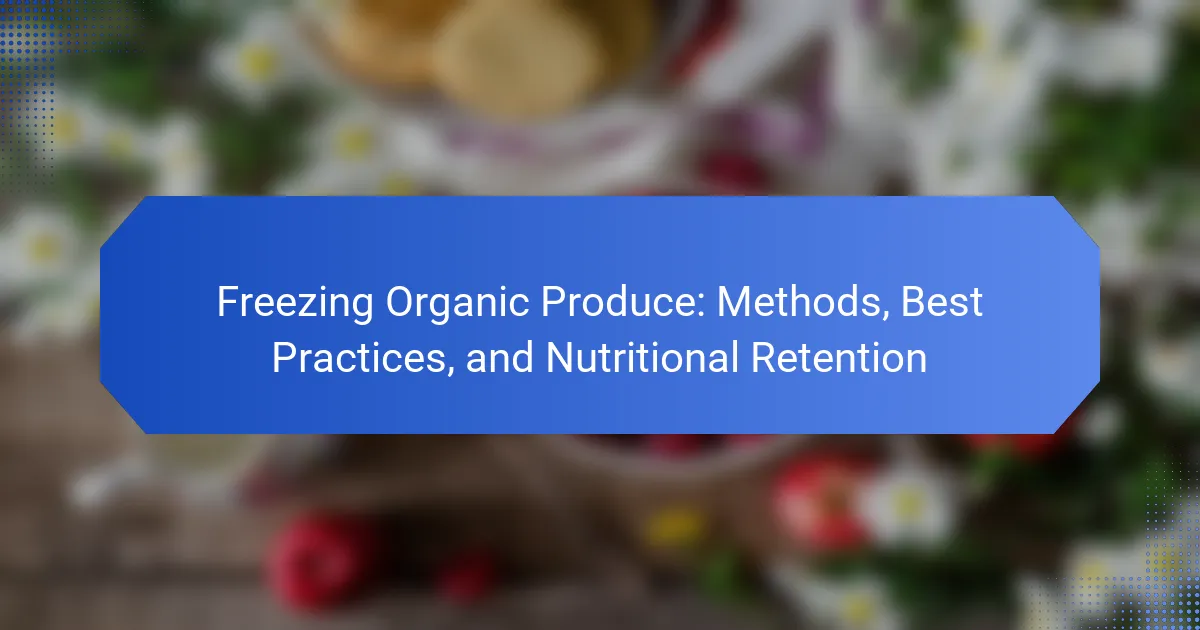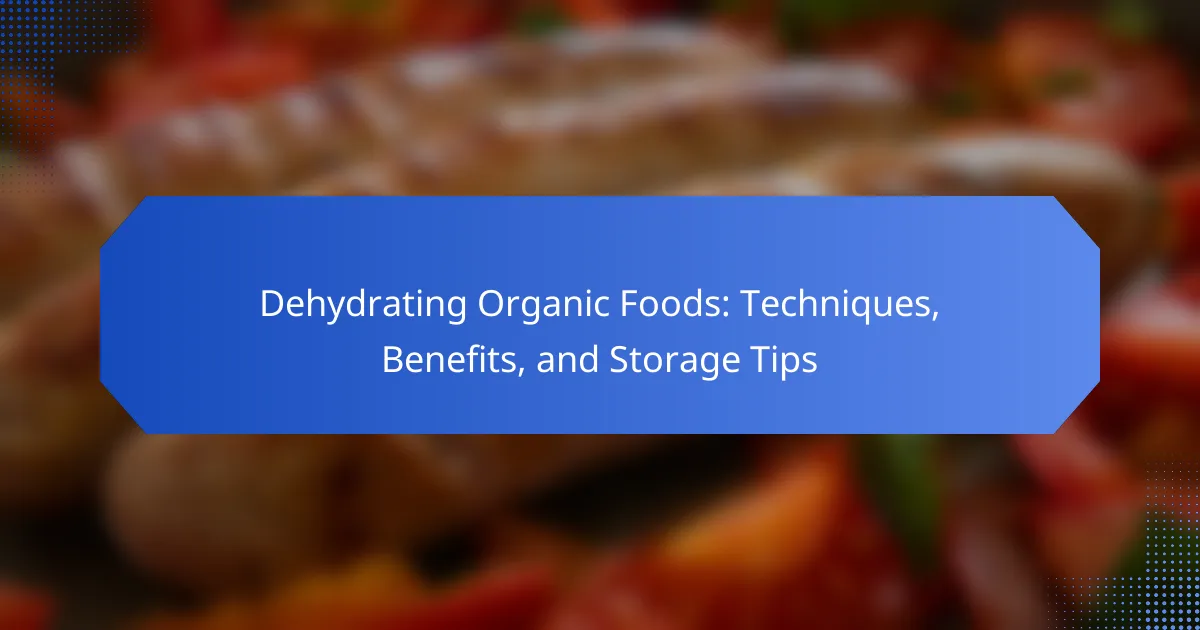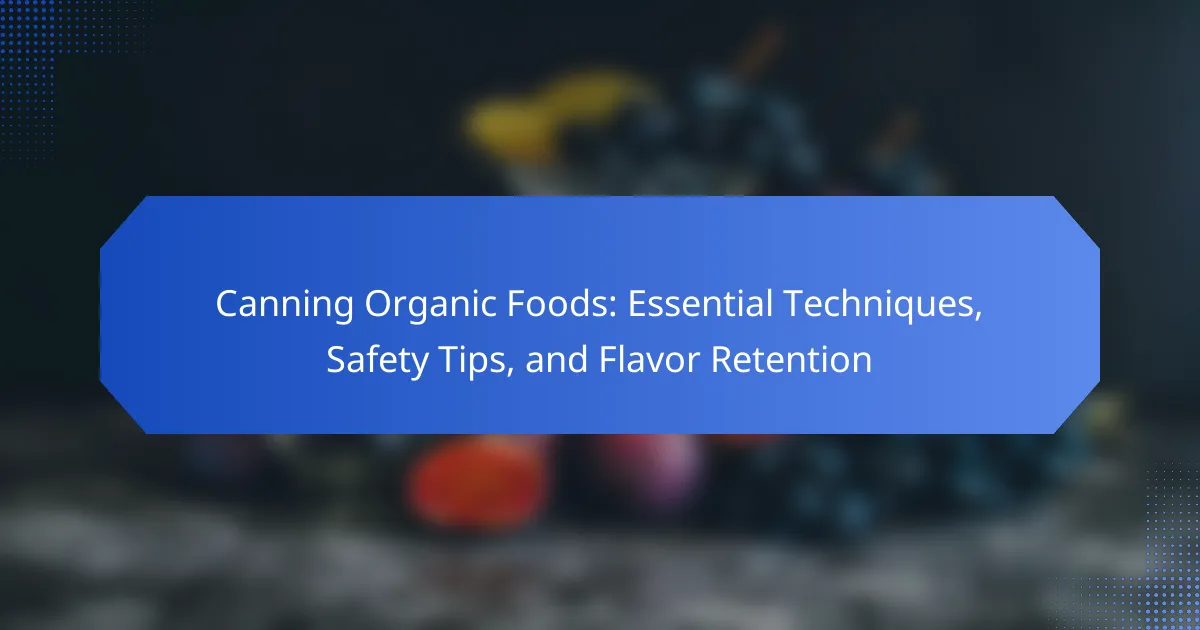Organic vegetable storage involves maintaining optimal conditions to extend shelf life and preserve nutritional value. Key factors for effective storage include cool temperatures between 32°F and 40°F, high humidity levels of 90-95%, and proper ventilation to minimize ethylene gas buildup. Various preservation techniques, such as refrigeration, freezing, canning, and drying, help retain the quality and safety of organic vegetables. Properly stored organic vegetables not only maintain higher nutrient levels but also provide significant health benefits, including improved digestion and a reduced risk of pesticide exposure. This article outlines these optimal storage conditions, preservation methods, and the associated health advantages of consuming well-preserved organic vegetables.

What are the optimal conditions for organic vegetable storage?
The optimal conditions for organic vegetable storage include cool temperatures, high humidity, and proper ventilation. Most organic vegetables thrive at temperatures between 32°F and 40°F. High humidity levels, around 90-95%, help prevent dehydration. Ventilation is essential to reduce ethylene gas buildup, which can accelerate spoilage. Specific storage methods vary by vegetable type. For example, leafy greens benefit from being stored in perforated bags to maintain moisture. Root vegetables like carrots and potatoes prefer dark, cool environments. These conditions significantly extend the shelf life of organic vegetables, preserving their nutritional value and freshness.
How does temperature affect organic vegetable storage?
Temperature significantly affects organic vegetable storage by influencing their freshness and shelf life. Higher temperatures can accelerate spoilage and promote the growth of pathogens. For example, storing vegetables at temperatures above 50°F can lead to faster deterioration. Conversely, cooler temperatures, typically between 32°F and 40°F, help preserve the quality of organic vegetables. This range slows down respiration and enzymatic processes that cause spoilage. Research indicates that maintaining appropriate storage temperatures can extend the shelf life of vegetables by several days to weeks. Proper temperature control is essential to minimize waste and maintain nutritional value.
What is the ideal temperature range for different types of vegetables?
The ideal temperature range for different types of vegetables varies. Leafy greens thrive best between 32°F to 40°F. Root vegetables like carrots and potatoes prefer temperatures around 32°F to 36°F. Tomatoes and peppers are best stored at 55°F to 70°F. Cucumbers should be kept at 50°F to 55°F for optimal freshness. These temperature ranges help maintain flavor, texture, and nutritional value. Proper storage conditions can extend the shelf life of vegetables significantly.
How can temperature fluctuations impact vegetable quality?
Temperature fluctuations can significantly impact vegetable quality. These fluctuations can lead to loss of texture, flavor, and nutritional value. For instance, high temperatures can accelerate respiration rates in vegetables. This process increases ethylene production, leading to quicker spoilage. Conversely, low temperatures can cause chilling injuries in sensitive vegetables. Chilling injuries result in off-flavors and undesirable textures. Studies show that maintaining a consistent temperature can extend shelf life. For example, storing leafy greens at stable, cool temperatures preserves their crispness and nutrients. Therefore, managing temperature is crucial for maintaining vegetable quality.
What role does humidity play in preserving organic vegetables?
Humidity plays a crucial role in preserving organic vegetables. It helps maintain the moisture content within the vegetables. Proper humidity levels prevent wilting and dehydration. High humidity can promote mold growth, which is detrimental. Ideal humidity levels range from 85% to 95% for most organic vegetables. This range helps retain freshness and nutritional value. Studies indicate that vegetables stored in optimal humidity can last longer. For example, leafy greens stored at higher humidity maintain crispness for days longer than those in dry conditions.
What is the recommended humidity level for various vegetables?
The recommended humidity level for various vegetables typically ranges from 85% to 95%. Leafy greens, such as lettuce and spinach, thrive at higher humidity levels around 90% to 95%. Root vegetables, like carrots and potatoes, prefer humidity levels of 85% to 90%. Cruciferous vegetables, including broccoli and cauliflower, benefit from humidity levels of 90% to 95%. These humidity levels help maintain freshness and prevent wilting. Proper humidity also reduces moisture loss, extending the shelf life of vegetables. Studies show that maintaining these humidity levels can significantly enhance vegetable quality during storage.
How does humidity affect the shelf life of organic produce?
Humidity significantly affects the shelf life of organic produce. High humidity levels can lead to increased moisture on the surface of fruits and vegetables. This moisture promotes the growth of mold and bacteria. Consequently, the produce may spoil faster. Conversely, low humidity can cause produce to dry out and lose quality. For example, leafy greens may wilt and become unappetizing. Maintaining optimal humidity levels, typically between 85% and 95%, can help preserve freshness. Studies show that proper humidity control can extend the shelf life of organic produce by several days to weeks.
Why is ventilation important in organic vegetable storage?
Ventilation is crucial in organic vegetable storage because it helps regulate temperature and humidity. Proper airflow prevents the buildup of moisture, which can lead to mold and decay. It also allows for the dissipation of ethylene gas, which some vegetables release and can accelerate ripening and spoilage. Studies indicate that maintaining optimal ventilation can extend the shelf life of stored vegetables. For instance, a research by the University of California found that well-ventilated storage conditions reduced spoilage rates by up to 30%. This illustrates the importance of ventilation in preserving the quality and safety of organic vegetables.
What are the best practices for ensuring proper ventilation?
Ensure proper ventilation by maintaining airflow in storage areas. Use fans or vents to circulate air. Keep storage spaces clean to prevent mold growth. Monitor humidity levels to avoid excess moisture. Store vegetables in breathable containers to enhance airflow. Regularly check for blockages in ventilation systems. Position stored vegetables to allow space between them. Implement these practices to prolong the freshness of organic vegetables.
How does ventilation prevent spoilage and decay?
Ventilation prevents spoilage and decay by promoting air circulation around stored organic vegetables. This circulation reduces humidity levels, which can foster mold and bacterial growth. Adequate ventilation also helps maintain a consistent temperature, preventing heat buildup that can accelerate decay. Furthermore, it allows for the removal of ethylene gas, a natural byproduct of ripening that can lead to spoilage. Studies show that proper airflow can extend the shelf life of vegetables by up to 30%. Thus, effective ventilation is crucial for preserving the quality and longevity of organic produce.
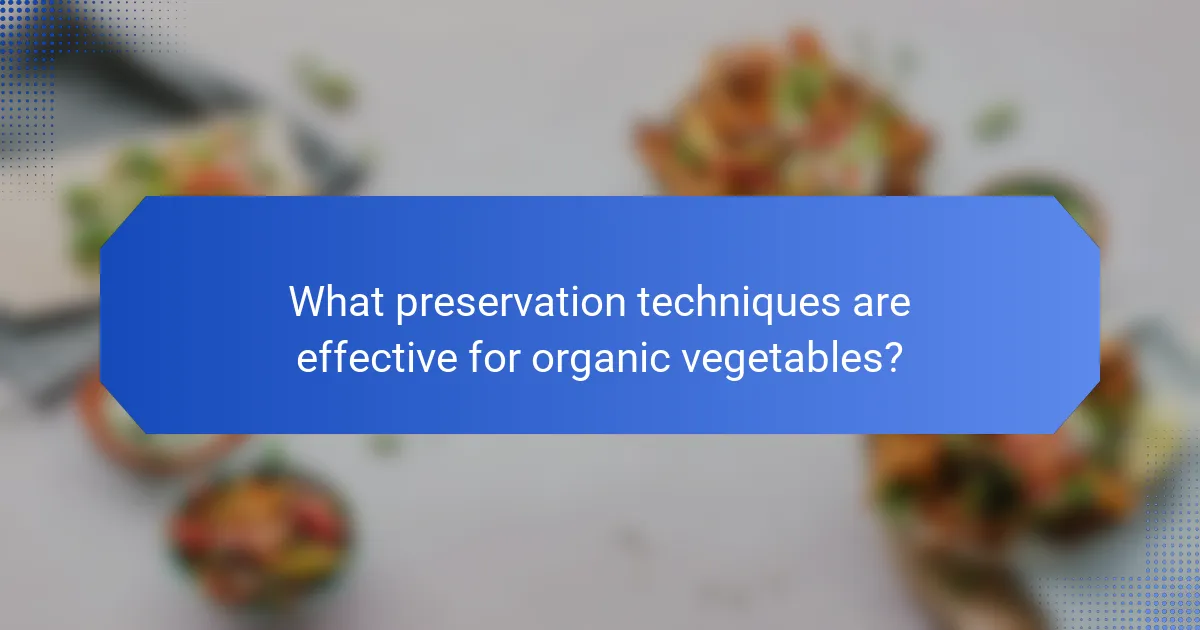
What preservation techniques are effective for organic vegetables?
Effective preservation techniques for organic vegetables include refrigeration, freezing, canning, and drying. Refrigeration slows down spoilage by maintaining a cool environment. Freezing preserves nutrients and extends shelf life significantly. Canning involves sealing vegetables in jars to prevent microbial growth. Drying removes moisture, inhibiting bacteria and mold. Each method retains the quality and safety of organic vegetables. Research shows that freezing can retain up to 90% of nutrients compared to fresh produce.
How can refrigeration enhance the longevity of organic vegetables?
Refrigeration enhances the longevity of organic vegetables by slowing down their metabolic processes. This cooling method reduces respiration rates, which in turn decreases spoilage. It also inhibits the growth of bacteria and molds that contribute to decay. Vegetables stored at temperatures between 32°F and 40°F can retain their freshness longer. For example, leafy greens can last up to two weeks in a refrigerator compared to a few days at room temperature. Research indicates that proper refrigeration can extend the shelf life of vegetables by 50% or more. Maintaining optimal humidity levels in the refrigerator further supports vegetable longevity by preventing wilting and dehydration.
What vegetables benefit most from refrigeration?
Leafy greens, such as spinach and lettuce, benefit most from refrigeration. These vegetables are sensitive to heat and can wilt quickly. Refrigeration slows down the respiration process. It helps retain their crispness and nutritional value. Carrots also thrive in cold environments. They remain crunchy and flavorful when stored in the refrigerator. Cruciferous vegetables like broccoli and cauliflower maintain their freshness better when chilled. The cold temperature prevents spoilage and extends shelf life. Additionally, bell peppers and cucumbers benefit from refrigeration, as it preserves their texture and taste. Overall, refrigeration is essential for maintaining the quality of these vegetables.
What are the best practices for refrigerating vegetables?
Refrigerating vegetables effectively maintains their freshness and nutritional value. Store vegetables in the crisper drawer, which maintains humidity. Use perforated plastic bags to allow airflow while preventing moisture loss. Keep ethylene-producing fruits, like apples, away from vegetables to prevent spoilage. Wash vegetables only before use to avoid excess moisture. Monitor temperature settings; ideally, keep the refrigerator at 32°F to 40°F. Certain vegetables, like potatoes and onions, should not be refrigerated as it affects flavor and texture. Following these practices can extend shelf life and preserve quality.
What are the advantages of freezing organic vegetables?
Freezing organic vegetables preserves their nutritional value and freshness. This method halts enzyme activity that can lead to spoilage. Studies show that frozen vegetables retain vitamins and minerals effectively. For instance, frozen peas maintain about 90% of their nutrients. Freezing also extends shelf life significantly, allowing for year-round access. It reduces food waste by enabling long-term storage. Additionally, freezing can enhance convenience for meal preparation. Overall, freezing is a practical solution for maintaining the quality of organic vegetables.
Which vegetables are best suited for freezing?
Vegetables best suited for freezing include broccoli, spinach, carrots, and green beans. Broccoli retains its nutrients and texture when frozen. Spinach is rich in vitamins and freezes well without losing its quality. Carrots maintain their flavor and crunch after freezing. Green beans preserve their color and taste effectively. These vegetables are commonly recommended for freezing due to their ability to withstand low temperatures without significant loss of quality.
How can freezing affect the nutritional value of vegetables?
Freezing can preserve the nutritional value of vegetables, but it may also lead to some nutrient loss. The freezing process causes ice crystals to form, which can damage cell structures. This damage may result in the loss of vitamins, particularly vitamin C and some B vitamins. Research indicates that frozen vegetables can retain most of their nutrients if blanched before freezing. Blanching helps inactivating enzymes that can cause nutrient degradation. A study by the USDA shows that frozen vegetables often have similar nutrient levels compared to fresh ones stored for several days. Therefore, freezing can be an effective method for maintaining nutritional quality when done correctly.
What methods can be used for drying organic vegetables?
Methods for drying organic vegetables include air drying, oven drying, and dehydrating. Air drying involves hanging vegetables in a well-ventilated area until moisture evaporates. This method is suitable for herbs and thinly sliced vegetables. Oven drying requires setting the oven at a low temperature and placing vegetables on a baking sheet. This method is efficient but can consume more energy. Dehydrators are specifically designed for drying food. They circulate warm air to remove moisture effectively. Each method preserves nutrients while extending shelf life. Studies indicate that properly dried vegetables retain up to 90% of their nutrients.
What are the best techniques for drying vegetables at home?
The best techniques for drying vegetables at home include air drying, oven drying, and using a food dehydrator. Air drying works well in low-humidity environments and requires hanging vegetables in a well-ventilated area. Oven drying involves spreading vegetables on a baking sheet and setting the oven to a low temperature, usually around 140°F (60°C). This method is faster but requires monitoring to prevent cooking. A food dehydrator is specifically designed for drying and provides consistent temperature and airflow, making it the most efficient method. Each technique maintains the nutritional value of the vegetables while extending their shelf life.
How does drying impact flavor and texture?
Drying significantly alters both flavor and texture of organic vegetables. The process concentrates flavors by removing moisture, which enhances sweetness and reduces bitterness. Texturally, drying transforms vegetables from crisp to chewy or crunchy, depending on the method used. For instance, sun-drying can produce a leathery texture, while dehydrators yield a more uniform crispness. Additionally, drying can intensify certain flavor compounds, making the produce more aromatic. This change is due to the concentration of sugars and acids as water evaporates. Studies show that dried vegetables can retain up to 80% of their original flavor profile, making them a popular choice for preservation.
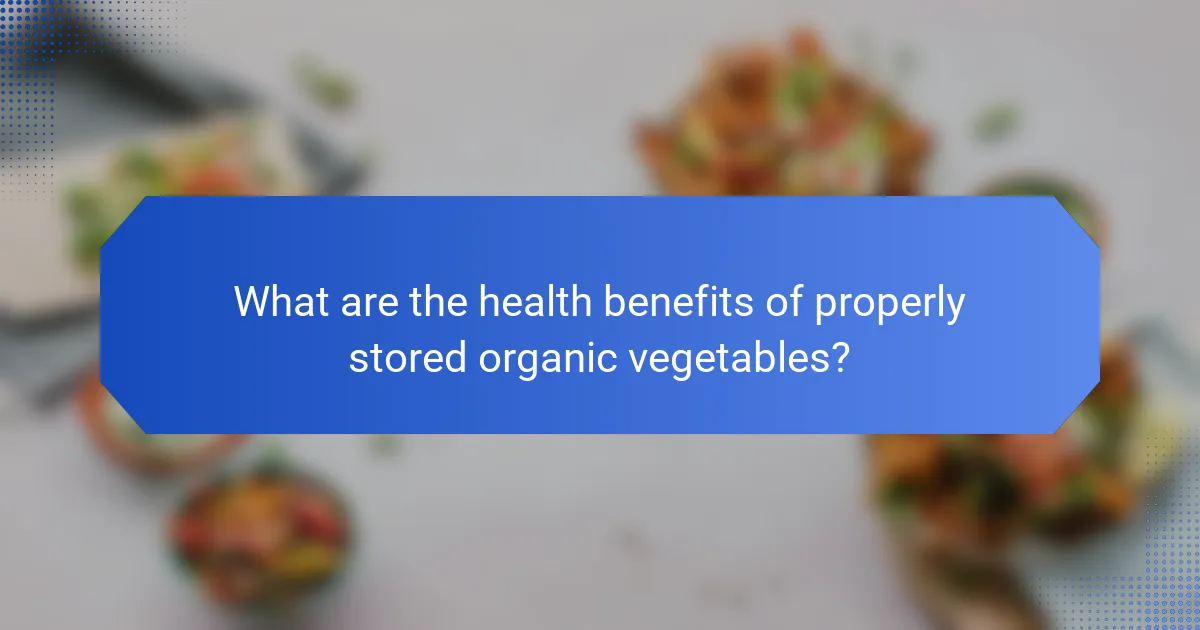
What are the health benefits of properly stored organic vegetables?
Properly stored organic vegetables provide numerous health benefits. They retain higher nutrient levels compared to improperly stored ones. This includes vitamins, minerals, and antioxidants essential for overall health. For instance, studies show that stored vegetables can maintain up to 90% of their nutrients when kept in optimal conditions. Proper storage also reduces spoilage, ensuring access to fresh produce. Fresh organic vegetables can improve digestion due to their fiber content. They support the immune system with essential vitamins like C and A. Additionally, consuming organic vegetables lowers exposure to harmful pesticides, promoting better health outcomes.
How does storage impact the nutritional value of vegetables?
Storage significantly impacts the nutritional value of vegetables. Proper storage conditions can preserve vitamins and minerals, while poor conditions lead to nutrient loss. For instance, exposure to light, heat, and moisture can degrade sensitive nutrients like vitamin C and B vitamins. Research shows that fresh vegetables stored in cool, dark places retain more nutrients than those kept at room temperature. A study published in the Journal of Agricultural and Food Chemistry found that broccoli stored in optimal conditions maintained higher levels of glucosinolates, beneficial compounds linked to cancer prevention. Additionally, the duration of storage affects nutrient levels; longer storage times typically result in greater nutrient degradation. Thus, effective storage methods are crucial for maintaining the nutritional integrity of vegetables.
What nutrients are most affected by improper storage?
Vitamins A, C, and B vitamins are most affected by improper storage. These nutrients are sensitive to light, heat, and moisture. For example, vitamin C can degrade rapidly when exposed to air and light. Studies show that improper storage can lead to a loss of up to 50% of vitamin C in fruits and vegetables. Similarly, B vitamins, such as thiamine and riboflavin, can diminish when stored in unsuitable conditions. Vitamin A, found in carrots and leafy greens, can also degrade if exposed to excessive light and heat. Proper storage conditions are crucial to maintain the nutritional quality of organic vegetables.
How can proper storage help maintain antioxidants in vegetables?
Proper storage helps maintain antioxidants in vegetables by slowing down their degradation. Antioxidants are sensitive to light, heat, and oxygen exposure. Storing vegetables in a cool, dark place minimizes these factors. For example, refrigeration can preserve the antioxidant levels in leafy greens for longer periods. Research indicates that storing broccoli at low temperatures retains up to 90% of its antioxidants. Additionally, using airtight containers can reduce oxygen exposure, further protecting these compounds. Therefore, optimal storage conditions directly influence the retention of antioxidants in vegetables.
Why are fresh, well-stored organic vegetables important for health?
Fresh, well-stored organic vegetables are important for health because they retain higher nutrient levels. Nutrients such as vitamins, minerals, and antioxidants are essential for bodily functions. Freshness ensures that these nutrients are available in optimal amounts. Proper storage methods prevent spoilage and nutrient loss. For example, storing vegetables in cool, dark places can extend their shelf life. Research indicates that fresh organic vegetables can contain up to 50% more antioxidants than non-organic counterparts. A study published in the Journal of Agricultural and Food Chemistry found that organic produce often has higher levels of phenolic compounds, which are beneficial for health. Therefore, consuming fresh, well-stored organic vegetables supports overall health and well-being.
What are the long-term health benefits of consuming stored organic vegetables?
Consuming stored organic vegetables provides numerous long-term health benefits. These benefits include enhanced nutrient retention over time. Organic vegetables often contain higher levels of vitamins and minerals compared to conventional options. For instance, studies indicate that organic produce can have up to 50% more antioxidants. Antioxidants are crucial for reducing oxidative stress and inflammation in the body.
Stored organic vegetables also support gut health due to their fiber content. Fiber aids in digestion and promotes a healthy microbiome. A healthy microbiome is linked to improved immune function. Additionally, consuming organic vegetables reduces exposure to synthetic pesticides. This reduction lowers the risk of developing chronic diseases over time.
Research from the Journal of Agricultural and Food Chemistry highlights these advantages. The study confirms that organic farming practices enhance the nutritional profile of vegetables. Overall, the long-term consumption of stored organic vegetables contributes to better health outcomes.
How can proper storage methods prevent foodborne illnesses?
Proper storage methods can prevent foodborne illnesses by inhibiting the growth of harmful bacteria. Maintaining appropriate temperatures is crucial; refrigeration slows bacterial reproduction. For example, keeping perishable items below 40°F (4°C) significantly reduces foodborne pathogen growth. Additionally, proper sealing of food prevents cross-contamination. This method protects food from exposure to contaminants present in the environment. Using airtight containers also reduces moisture, which can foster bacterial growth. Regularly checking expiration dates ensures that spoiled items are discarded promptly. Following these storage practices can decrease the risk of foodborne illnesses significantly.
What are the best practices for organic vegetable storage?
The best practices for organic vegetable storage include keeping vegetables in a cool, dark, and humid environment. This prevents spoilage and maintains freshness. Use breathable storage containers like mesh bags or perforated plastic. These allow air circulation while retaining moisture. Separate ethylene-producing fruits from vegetables to avoid premature ripening. Store leafy greens in a damp paper towel to keep them crisp. Regularly check for spoilage and remove any affected items to prevent the spread. These methods can extend the shelf life of organic vegetables significantly.
How can consumers effectively implement these practices at home?
Consumers can effectively implement organic vegetable storage practices at home by following specific techniques. First, they should store vegetables in a cool, dark place to maintain freshness. Refrigeration is ideal for most leafy greens and delicate vegetables. Consumers can also use breathable bags to allow air circulation while preventing moisture buildup. Additionally, proper washing and drying before storage can reduce spoilage. Certain vegetables like potatoes and onions should be kept in separate, well-ventilated areas to avoid ethylene gas exposure. Regularly checking stored vegetables for signs of decay helps prevent spoilage from spreading. These practices can extend the shelf life of organic vegetables, ensuring they remain nutritious and flavorful.
What common mistakes should be avoided in organic vegetable storage?
Common mistakes to avoid in organic vegetable storage include improper temperature settings. Storing vegetables at incorrect temperatures can lead to spoilage. For example, root vegetables thrive in cool, dark places. Exposure to light can cause potatoes to sprout and green.
Another mistake is neglecting humidity levels. High humidity can promote mold growth, while low humidity can cause vegetables to wilt. Additionally, overcrowding storage containers can restrict airflow. This restriction increases the risk of spoilage.
Failing to clean vegetables before storage can also lead to issues. Residual dirt can harbor bacteria, which accelerates decay. Lastly, not using breathable storage materials is a common error. Plastic bags trap moisture, leading to faster spoilage.
The main entity of the article is organic vegetable storage, which encompasses optimal conditions, preservation techniques, and health benefits. The article details the ideal temperature and humidity levels necessary for maintaining the freshness and nutritional value of organic vegetables, emphasizing the importance of proper ventilation to prevent spoilage. It outlines effective preservation methods such as refrigeration, freezing, canning, and drying, while also discussing the long-term health benefits of consuming well-stored organic produce. Additionally, the article highlights best practices for storage and common mistakes to avoid, ensuring that readers can maximize the quality and safety of their organic vegetables.
